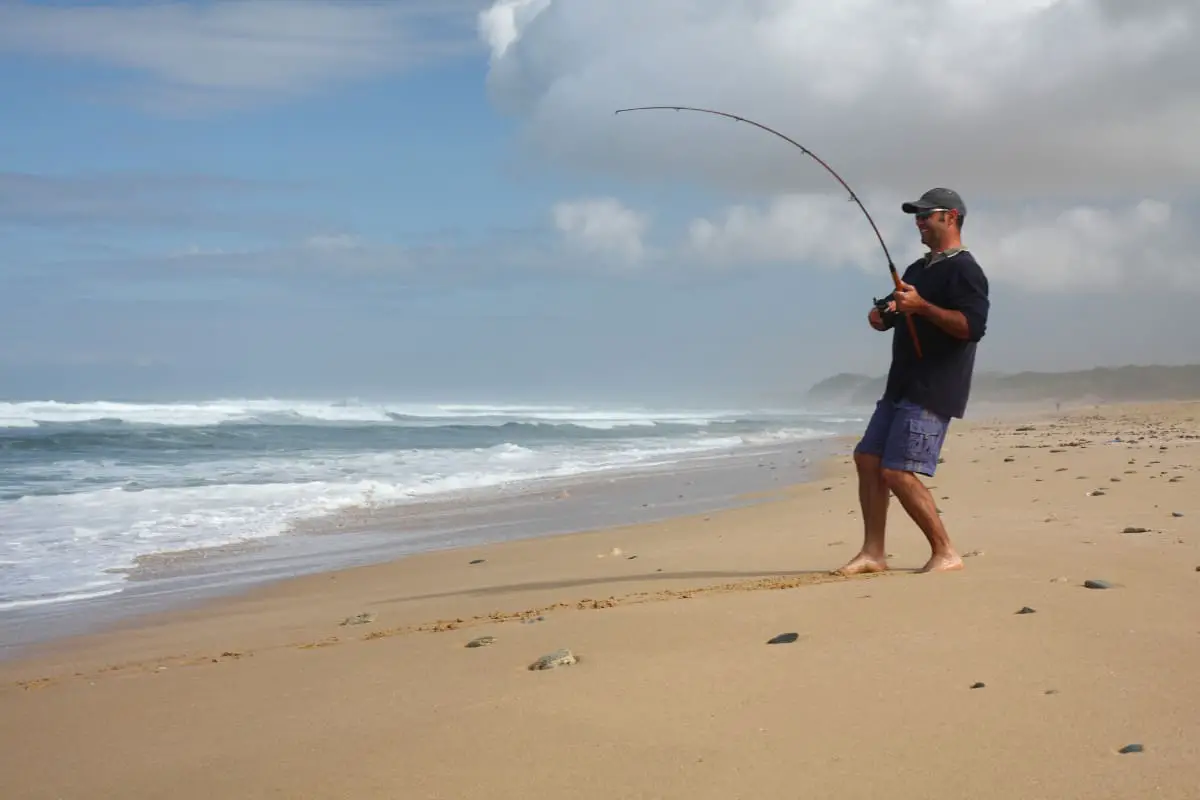When you go fishing, you need to be prepared.
For some reason, not many people talk about this. Granted, there is a lot of fish in the water, but without having a decent knowledge about what fish species you can target while surf fishing, how are you supposed to prepare?
Of course, you can grab the most popular bait hit the beach and keep your fingers crossed, but this is not what we are all about here.
I suppose this can be one of the best things about surf fishing. You never know what you are going to catch.
But this can also be very frustrating.
Below I will explain what the different fish types you can catch while surf fishing is.
Fish are known to migrate and move a lot. So, depending on your location, the time of the year, the time of the day or night, weather conditions, and so much more, the fish species you may be able to target can vary.
What Different Types of Fish Are There?
It has always surprised me how many several fish species one can catch while fishing. But even then, that number pales in comparison to the nearly 28,000 known fish species we have today.
If we go back to biology 101, we will discover that generally speaking fish are falling into two main categories: freshwater and saltwater fish.
The majority, or about 96% of them, are bony fish, 3% are sharks, chimeras and rays, and the rest 1% hagfish and lampreys.
But they can also be separated into different types:
- Bony fish – tuna, bass, Halibut, carp, minnows;
- Cartilaginous fish – sharks, stingrays, skates;
- Jawless fish – lampreys, hagfish;
On the other hand, we can separate the fish in different groups according to their habitat.
- Shallow sandy fish;
- Shallow rocky fish;
- Deep sandy fish;
- Deep rocky fish;
- Coral reef fish;
- Surf fish;
- Bay fish;
- Pelagic fish; and
- Demersal fish.
Each category has a lot of different fish species, some of which we may not be able to catch from the beach.
For example, even though pelagic fish are found in deeper waters, some of them do come closer to the shore and can be caught from the beach. While for others, you will need to go offshore fishing.
What Types of Fish Can You Catch When Surf Fishing?
There are just so numerous different types of fish. But you will not be able to catch every single one of them.
You will be limited by the casting distance, as not all of these fish will be near the beach or even in the inshore area.
Usually, while surf fishing, most people cast between 20 to 100 yards. The actual distance will vary from person to person and depending on their gear and the weather conditions.
Some fish species can only be caught offshore and in open waters. And this cuts down the number of different fish types we can catch from the beach significantly.
So, let’s take a look at what fish we can target.
1. Striped Bass
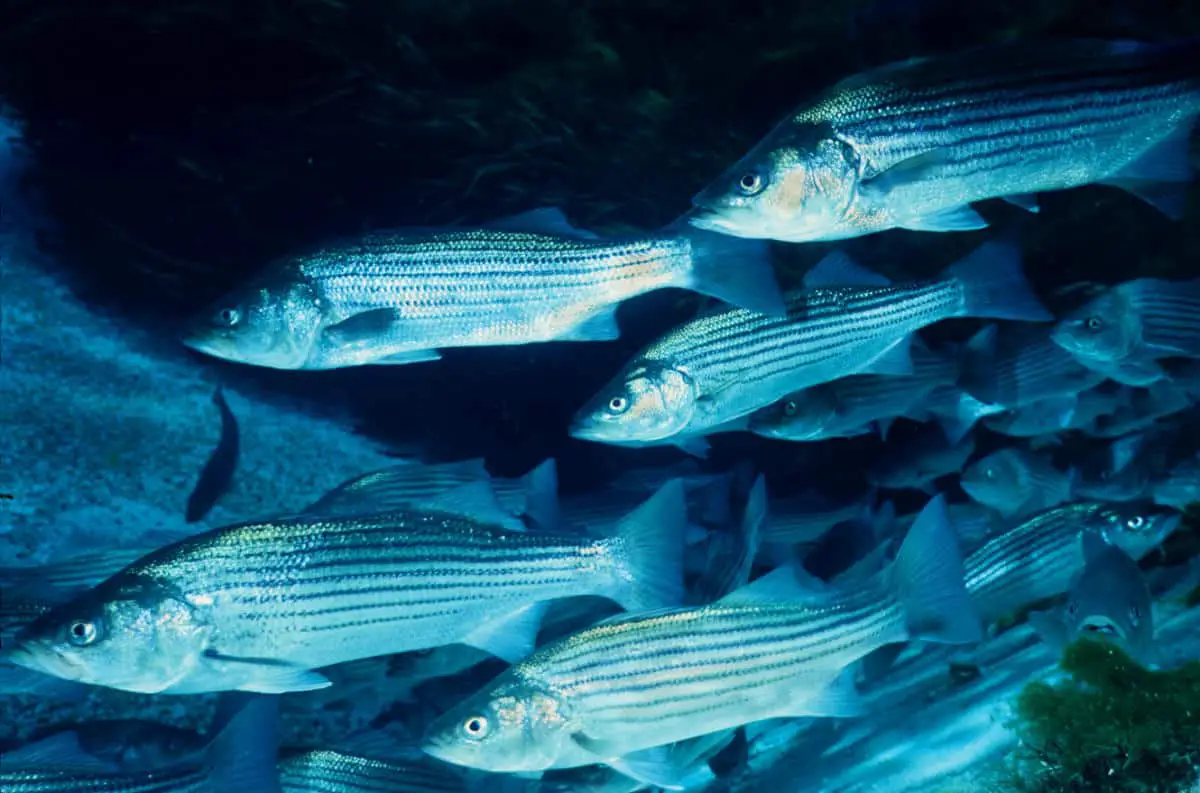
We have at least a few different names for the striped bass like Rockfish, Striper, Linesider, and so much more.
They are native to the East Coast and the Gulf of Mexico.
They inhabit the areas from Maine down south to Florida and along the coast west to Louisiana.
Striped bass prefers moving waters and is best caught on living and cut bait like eels and squid.
They are more active during the night when they usually feed. Fishing for stripers early in the morning can also be very productive.
With time the striped bass was introduced to the West Coast.
So it can also be caught in California in the San Francisco Bay area and the Delta System. After they spawn in the spring, they migrate out in the ocean, and during the summer, they can be caught from the beaches along California.
2. Surfperch
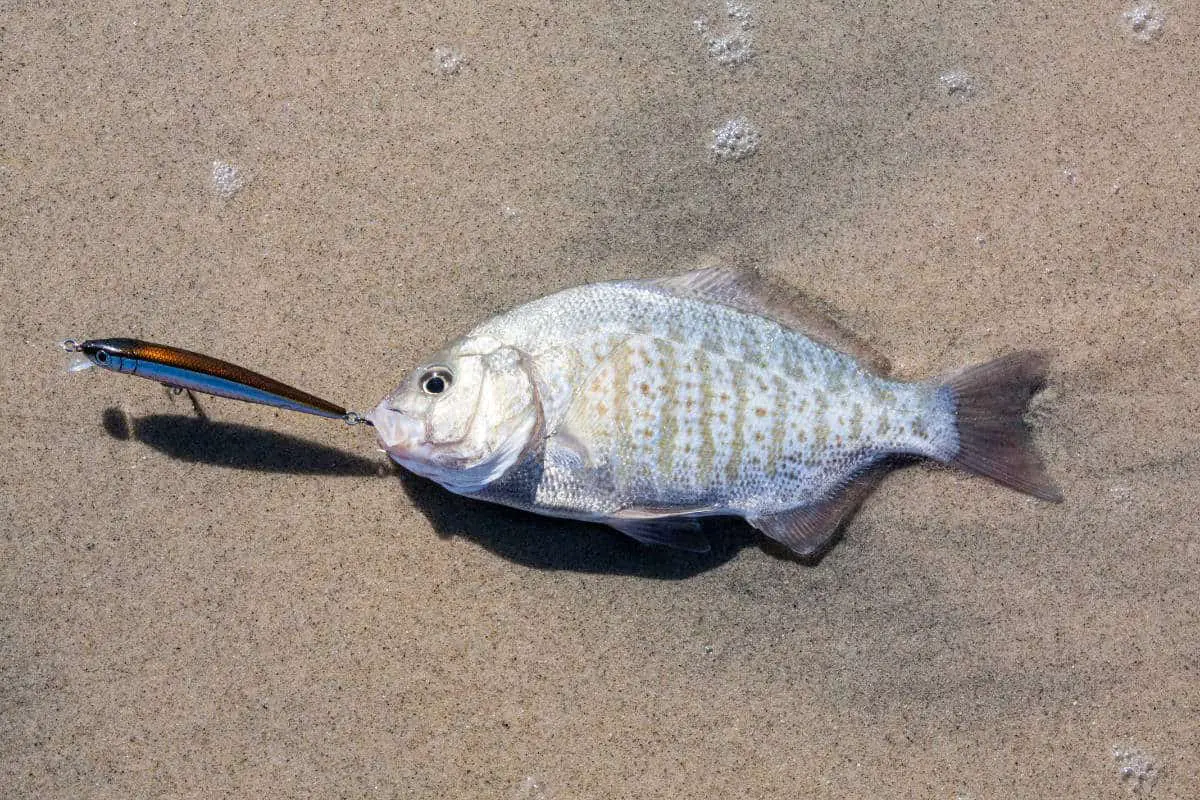
The surfperch inhabits the Eastern Pacific Ocean and can be found through the whole west coast, starting from California and up to Washington.
There is a wide variety of different types of surfperch that you can target, like: Barred, Walleye, Redtail, Calico, and Silver Surfperch.
Frequently they can be found as close as 30 feet from the shore. They prefer deeper holes and depressions along the bottom, rocky, and sandy areas around jetties.
The best bait for surf perch is usually Sandworms, mussels, and sand fleas.
is usually Sandworms, mussels, and sand fleas.
However, if none of this is available, you can also use artificial lures like Lucky craft flash minnow, swimbaits (motor oil), and Berkley gulp saltwater artificial worms.
3. Snook
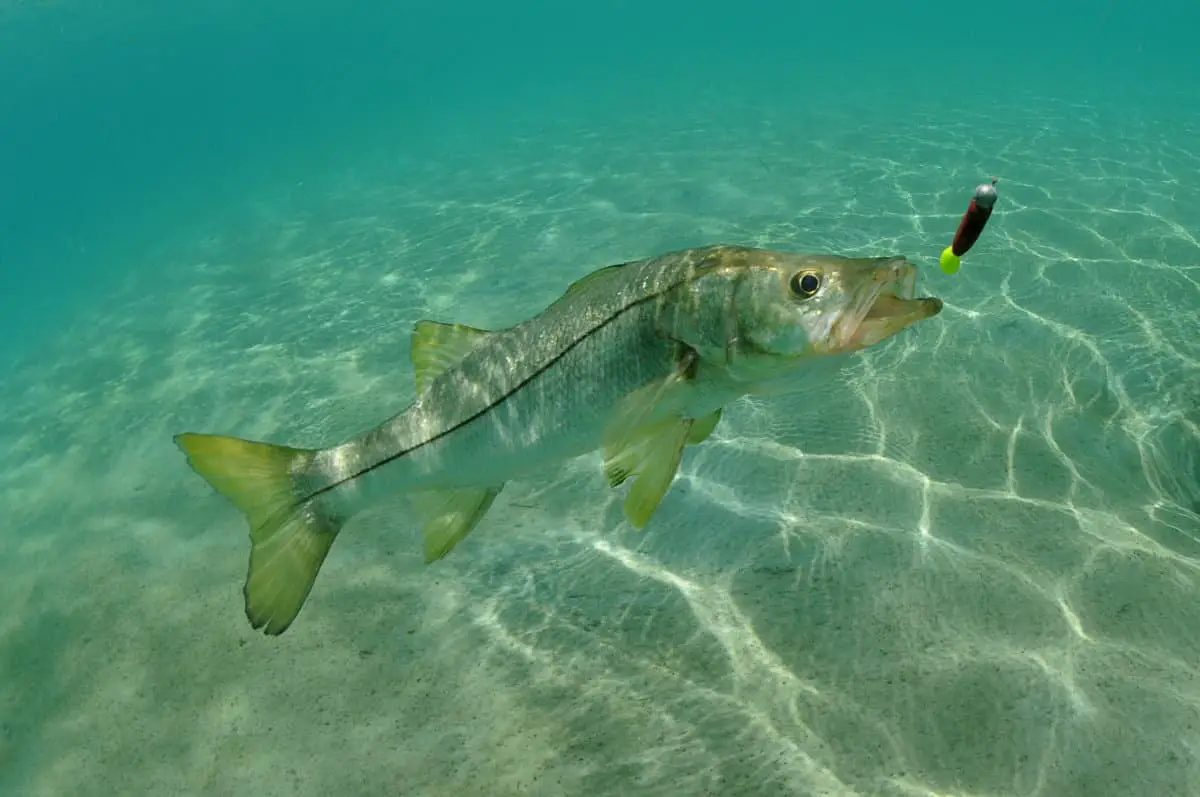
Snook is a common fish species that inhabit the Gulf of Mexico, and shore areas around Florida. Usually, Snook does not venture north of Florida, although there have been some reports of them migrating as north as New York.
Around the beaches of Florida, you can find five different Snook species: common Snook, small and large-scale fat Snook, tarpon snook, and sword spine snook.
Anglers enjoy fishing for Snook because they bite very aggressively and like to fight a lot.
They are most active at night and during low light conditions when they usually feed.
Live baits like shrimp, mullet, or sardines work best. However, the best bait may vary depending on your location, so it is recommended to catch and use bait from the area you are fishing.
4. Bonito
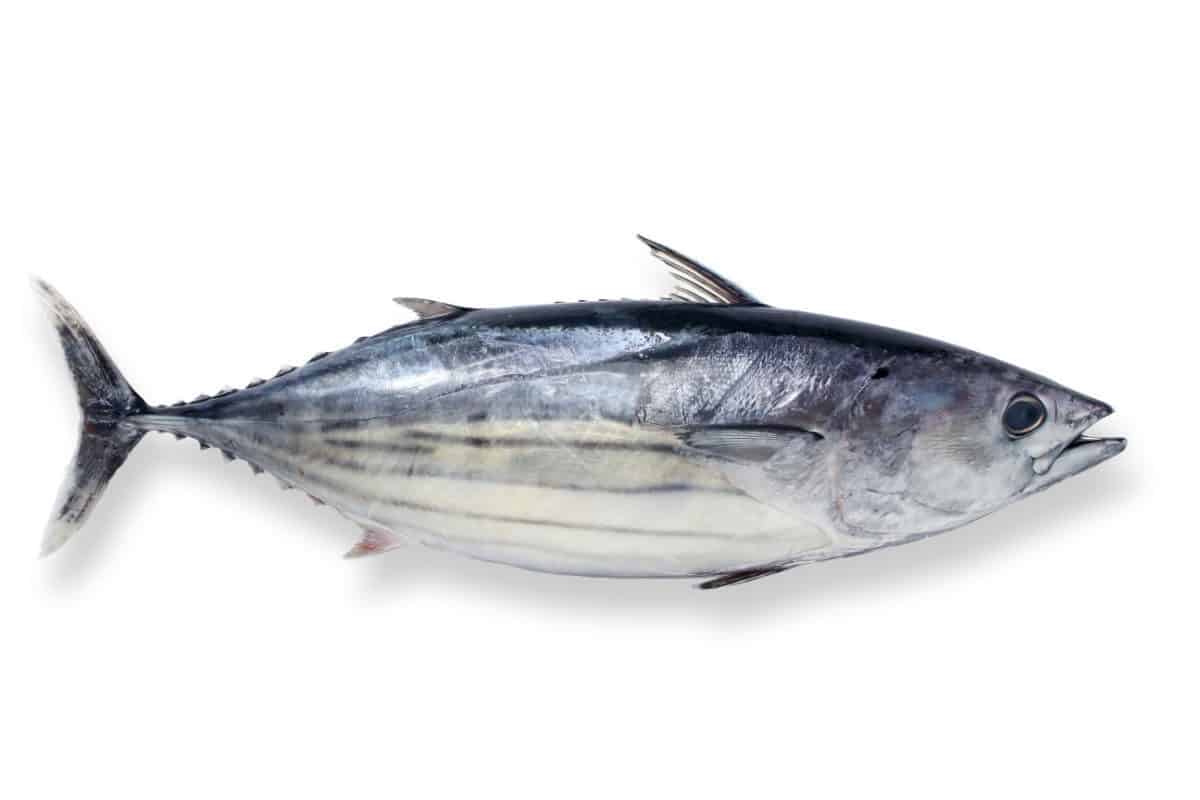
Bonito is another very popular fish species that many anglers enjoy fishing for.
Bonito can be found near close to the shore and coastal areas with more structure in both the Atlantic and the Pacific.
They put up a good fight as well, making them a fun fish to go after and are relatively easy to catch.
You can catch them with a fresh cut and live bait like anchovy and sardines, small lures, and more.
Some anglers stated bonito does not have outstanding taste qualities, and many refer to it as trash fish. But for me, this is one of the best fish I have eaten. In my own opinion, it all depends on how you prepare the fish; this fish is good for sinaing (Sinaing na Tulingan ).
).
5. Bluefish
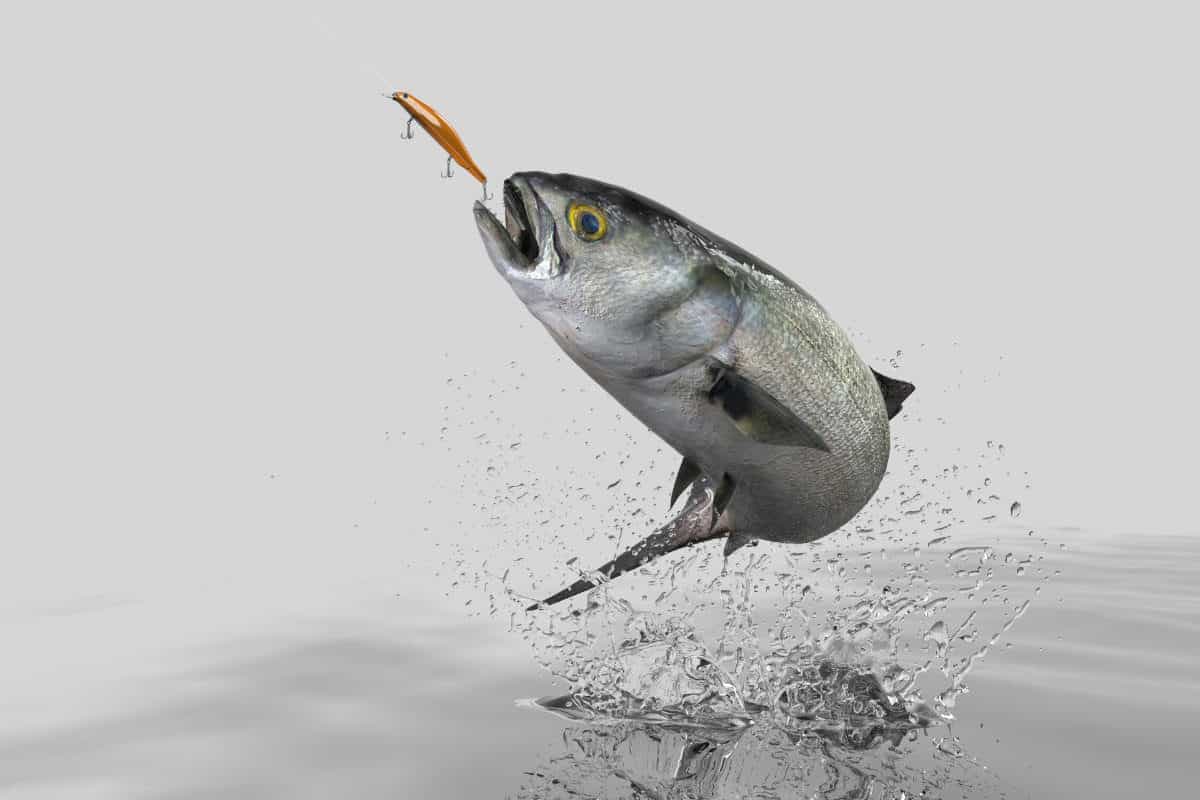
Bluefish can be found along the whole East Coast from Maine to Florida and along the Gulf of Mexico. They are migratory fish species that move north during the spring and come back south in the autumn and winter.
Bluefish are well known for their very sharp teeth, which can cut through even some of the thickest fishing line. This is why a wire leader is almost always a must-have.
Bluefish usually will bait at almost anything, making them an easy catch.
6. Pompano
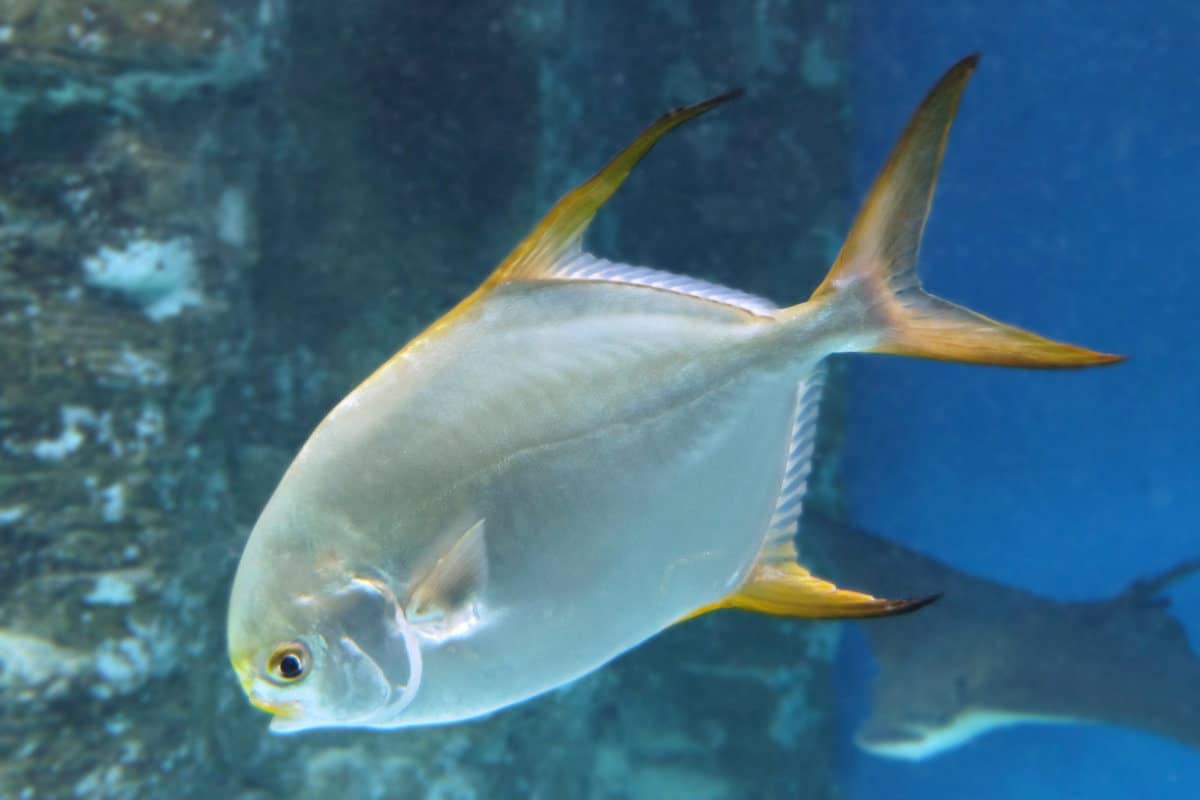
If you have been surf fishing for at least a little while, you most definitely have already heard stories about the Pompano fish.
Pompano is most commonly found near Florida. However, their habitat stretches quite a bit. They are a migratory fish that like warm waters. During the summer, they tend to go north, and during the winter, they go back south again.
Usually, they can be found from Massachusetts down to Florida and the Gulf of Mexico.
They are one of the most popular types of fish because they like to fight a lot but are relatively easy to catch and taste terrific.
Pompano is best caught on crabs, shrimp, sand fleas, squid, clams, mussels, and more.
They can commonly be found close to the beach and around piers. The best locations for pompano are deeper areas and cuts between sandbars.
are deeper areas and cuts between sandbars.
7. Whiting
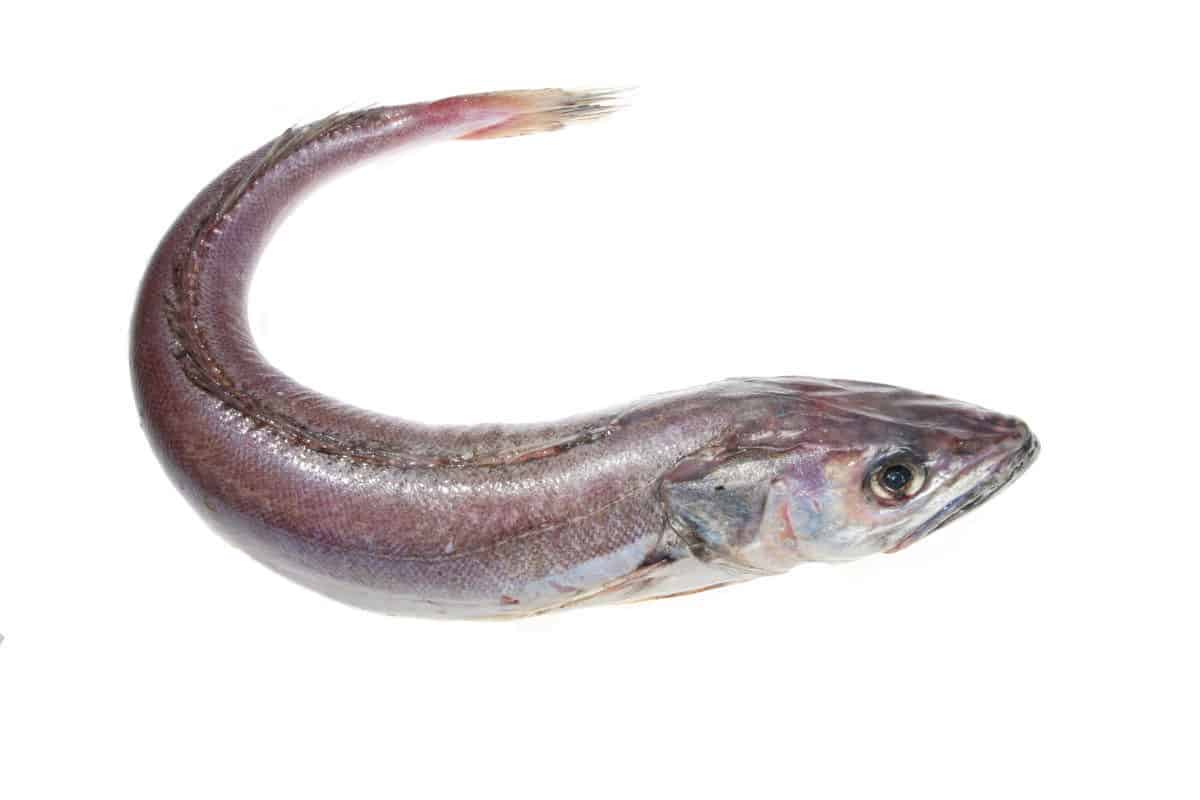
Three different fish species are referred to as Whiting. These are (1) the Southern Kingfish, (2) the Northern king croaker, and (3) the Gulf kingfish.
Whiting is migratory fish and prefers moderate temperatures. This is why in the fall, they migrate south, and during the summer, they usually travel back north.
They can be found on both coasts and in the Gulf of Mexico.
Whiting can be caught from the beach as they like to stay in troughs, inlets, and channels.
8. Halibut
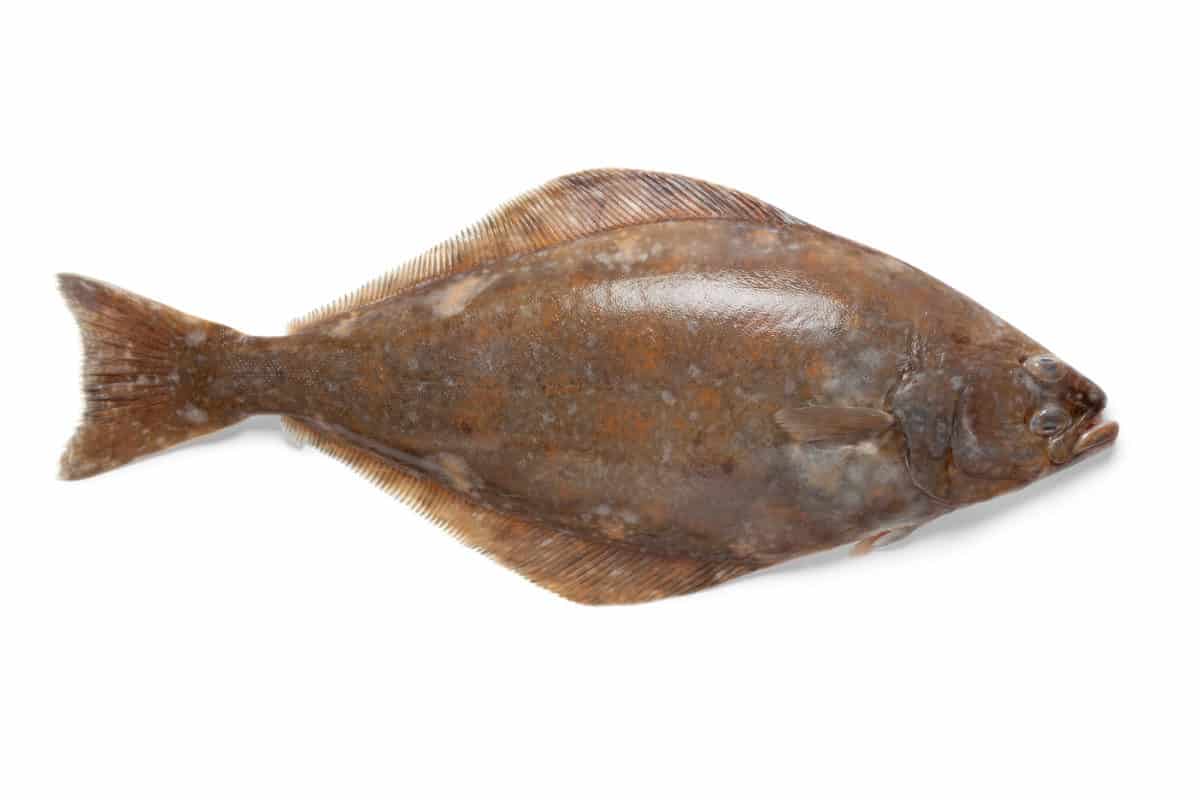
Halibut can be caught on both the East and the West Coasts. The Halibut is not a migratory fish species.
Usually, during the winter, it prefers to go into deeper waters, but during the warmer months, it can be found into shallower waters offshore but also closer to the beach. This is making surf fishing for Halibut a possibility.
a possibility.
Halibut can frequently be caught from jetties, near estuaries river tidal mouths, and piers.
Open beaches are not a very good location to fish for Halibut although they can be found in places with more structure and in troughs.
Some of the best baits for the Halibut are sardines, shrimp, anchovies, lures, spoons, swimbaits, and more.
9. Smelt
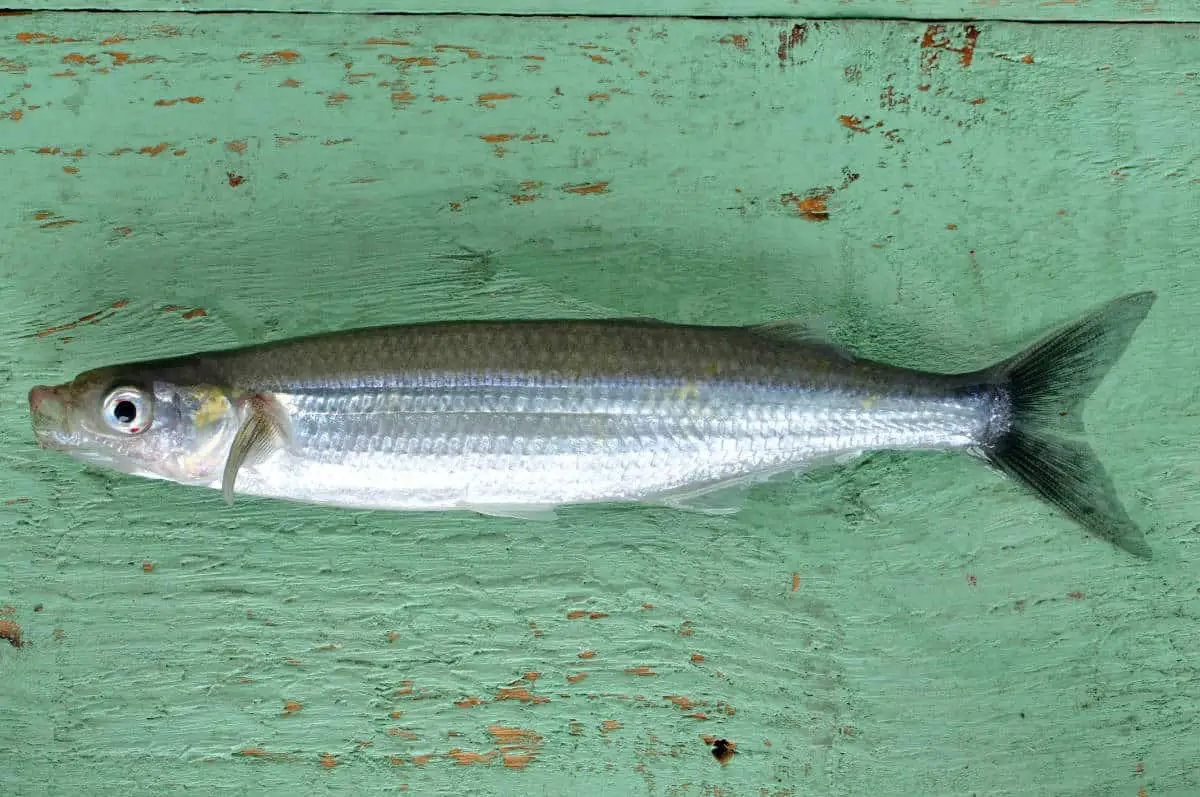
There are a variety of different types you can encounter like the: Jacksmelt, Surf smelt, and Night smelt.
Smelt can be found in the Northern parts of both the Pacific and Atlantic Oceans. During the spring, they migrate and can be caught from the coastline.
I’ve caught a few dozen Jacksmelt here in the bay area. They can be caught with sandworms and sandfleas base on my experience.
10. Ladyfish
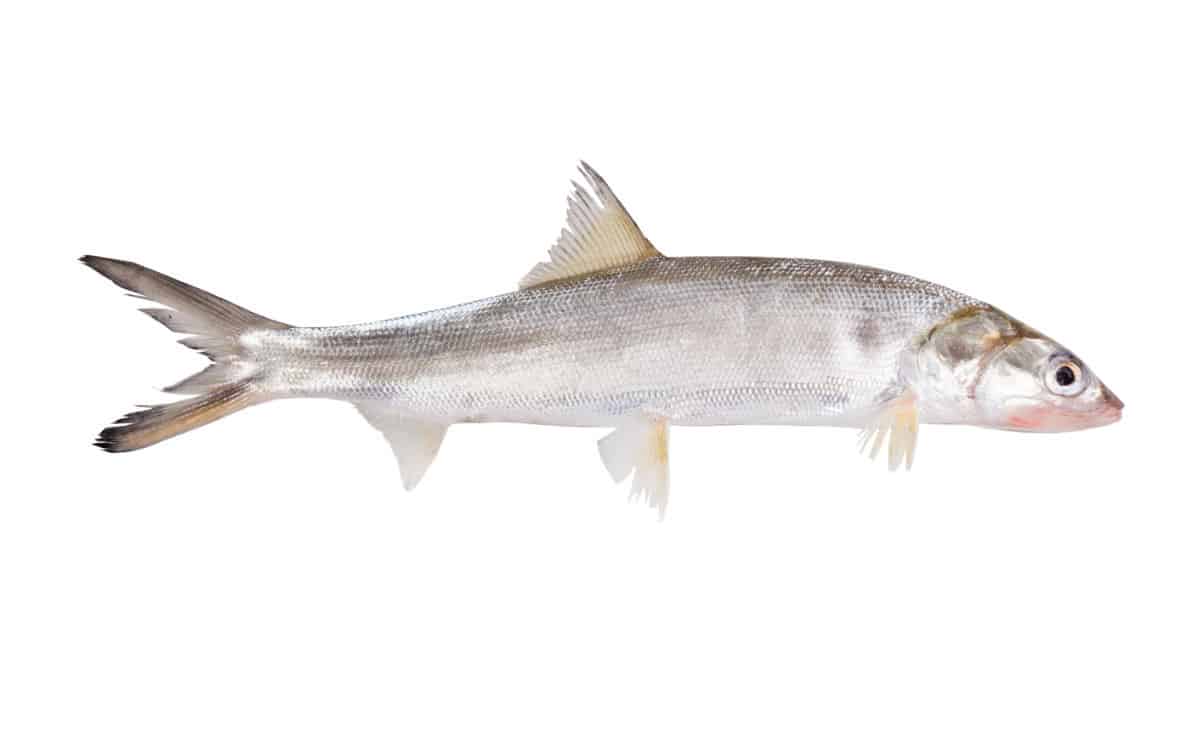
Ladyfish are a fun fish to catch, they are very lively and energetic, and put up a good fight. They tend to bite throughout the whole day and are relatively easy to catch.
They inhabit the areas from Massachusetts down south to Florida and throughout the Gulf of Mexico. Ladyfish are usually found near brackish regions of water. These are the areas where there is a mixture of salt and freshwater.
The ladyfish are a predatory fish species and can be caught with small silvery baitfish, anchovies, sardines, mullet, small silver spoons, plugs, and more.
11. Mackerel
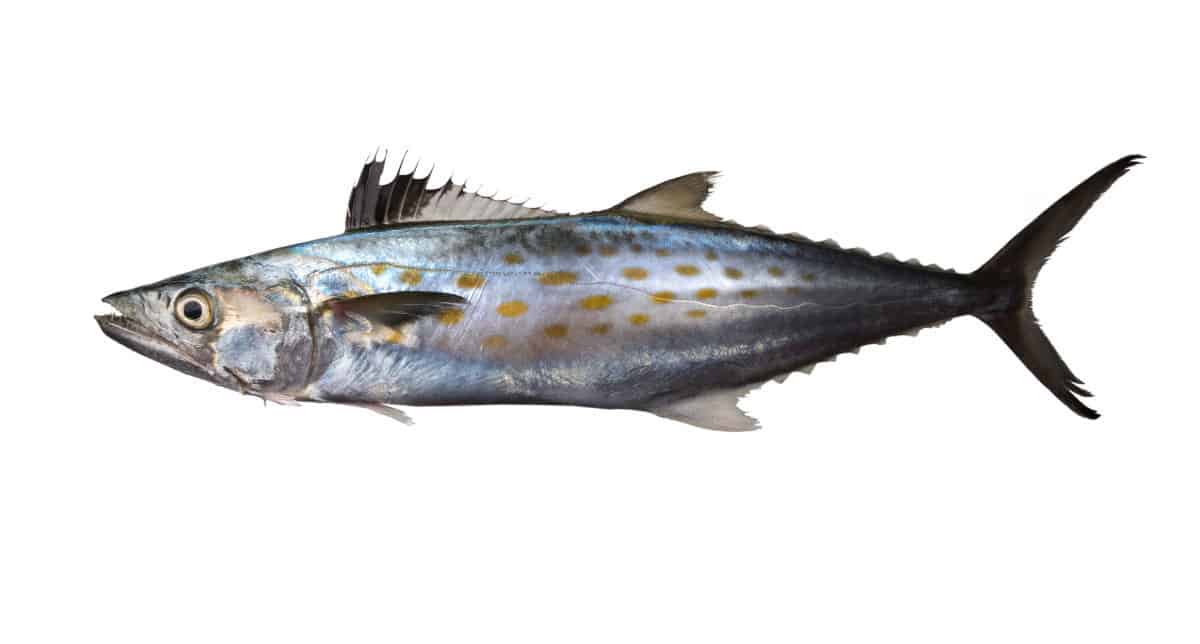
King mackerel (also known as Kingfish) and Spanish mackerel can be found throughout the Gulf of Mexico and on the East Coast south of North Carolina.
Kingfish are usually found in deeper water. This is why the best chances for catching them is by fishing from piers, docks, and rocks that are further into the ocean.
Both of these fish are extremely fun to catch and put up a great fight.
12. Sharks
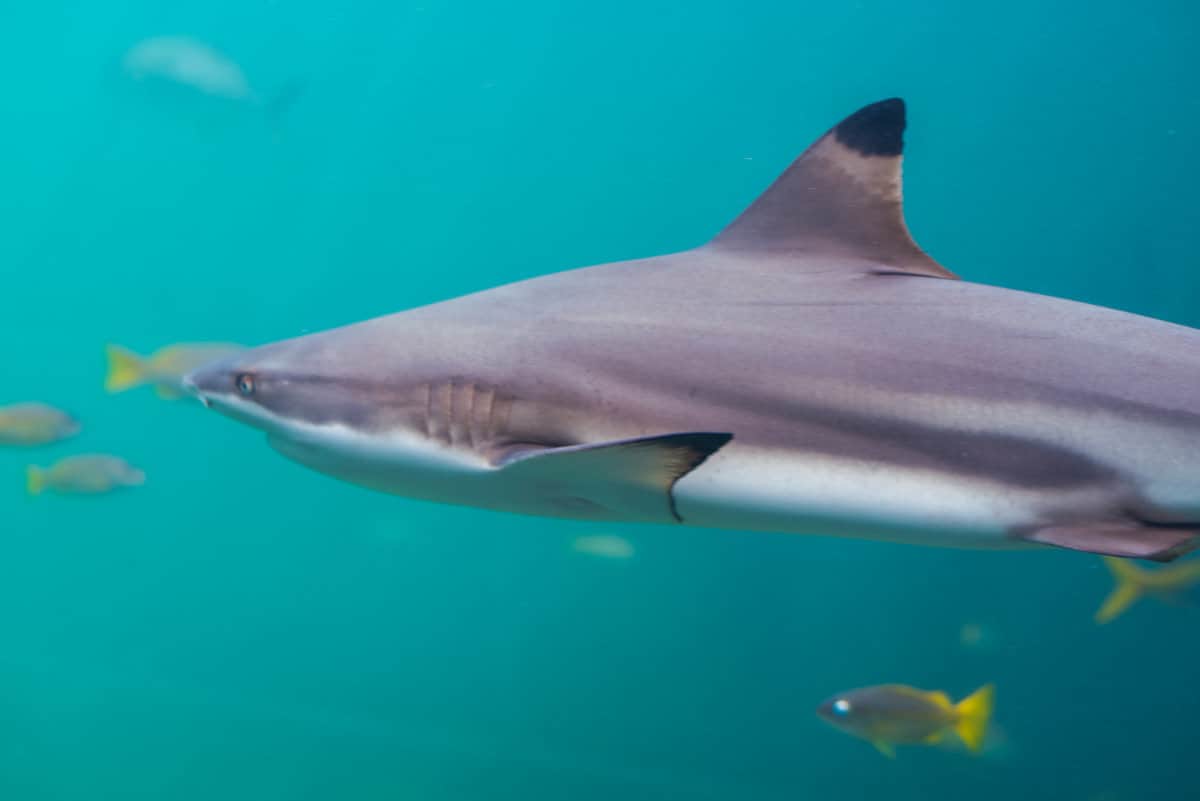
Blacktip sharks can be found in different tropical and subtropical areas: starting from Massachusetts and going down south to Florida and throughout the Gulf of Mexico.
There are sharks on the West Coast, as well. However, the chances of catching one are much lower.
Florida is the best destination for shark fishing.
The best bait for sharks is usually live or cut bait. Mullet, bluefish, Kingfish, ladyfish, and the perfect bait for catching sharks.
13. Red Snapper
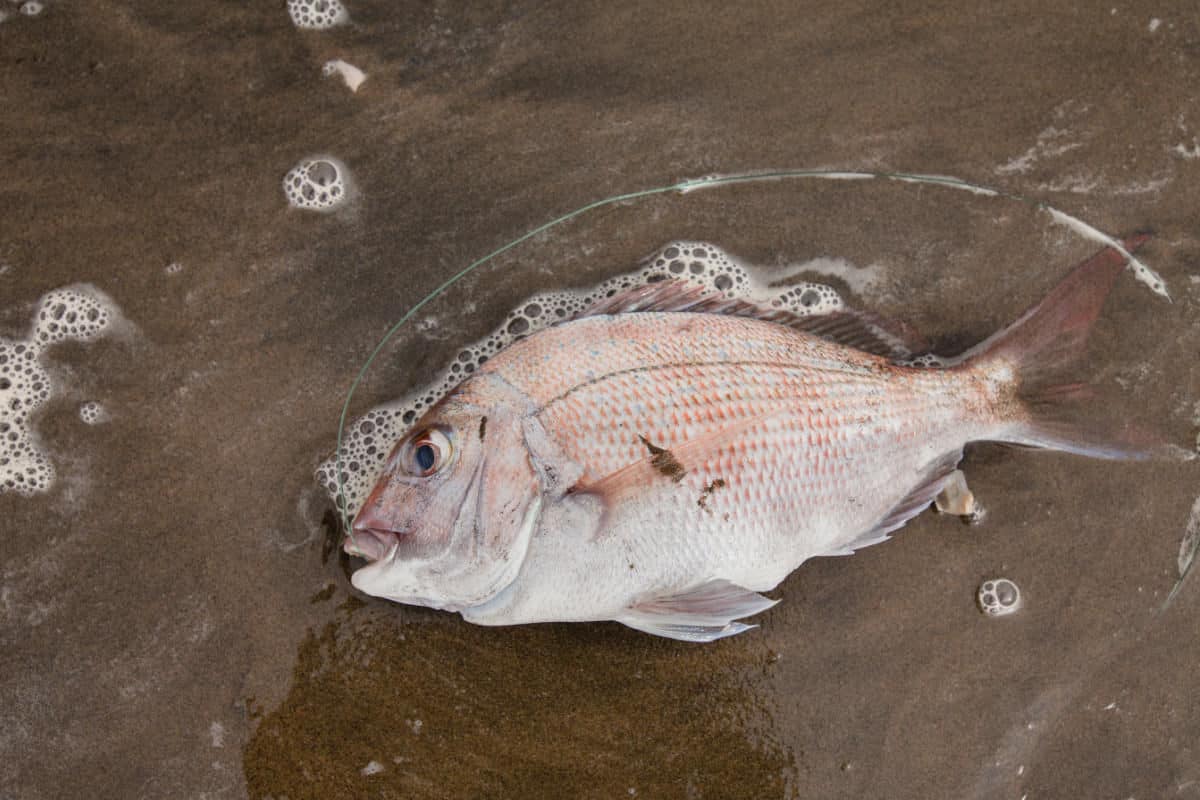
The red snapper is a highly prized game fish.
It is a bottom-dwelling fish and can be found on the East Coast and in the Gulf of Mexico at depths starting from 30 and going down to 250 feet.
Red snappers can be very hard to catch from the beach, but it is not necessarily impossible.
Red snappers are targeted best with fresh and cut bait like squid and bonito.
An interesting fact is that on the West Coast, a specific type of rockfish is frequently referred to as snapper. However, this is not a real red snapper.
14. California Corbina
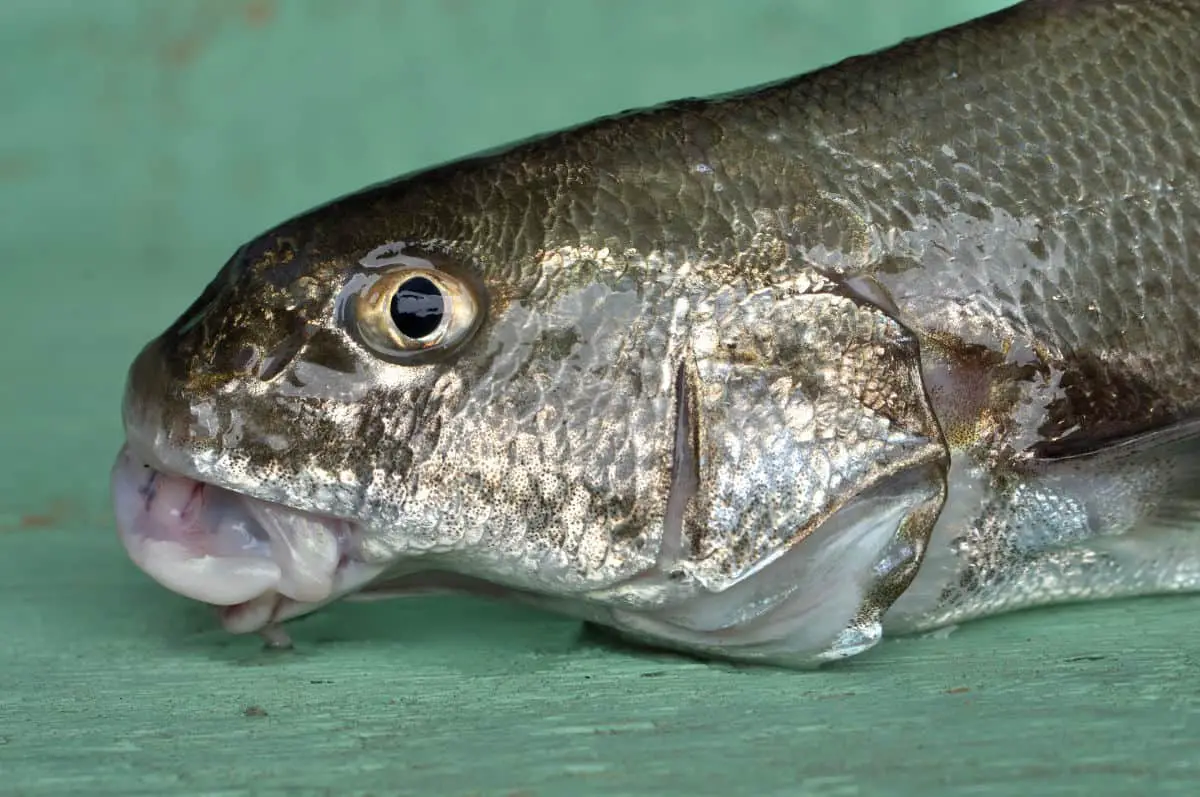
The California corbina is another fish that anglers often catch.
The California corbina likes sandy beaches and shallow bays. It is a bottom-feeding fish and can be found both in very shallow waters and deeper waters up to 45 feet.
You can find the California corbina along the Gulf of California in Mexico up to Point Conception in California.
15. Tarpon
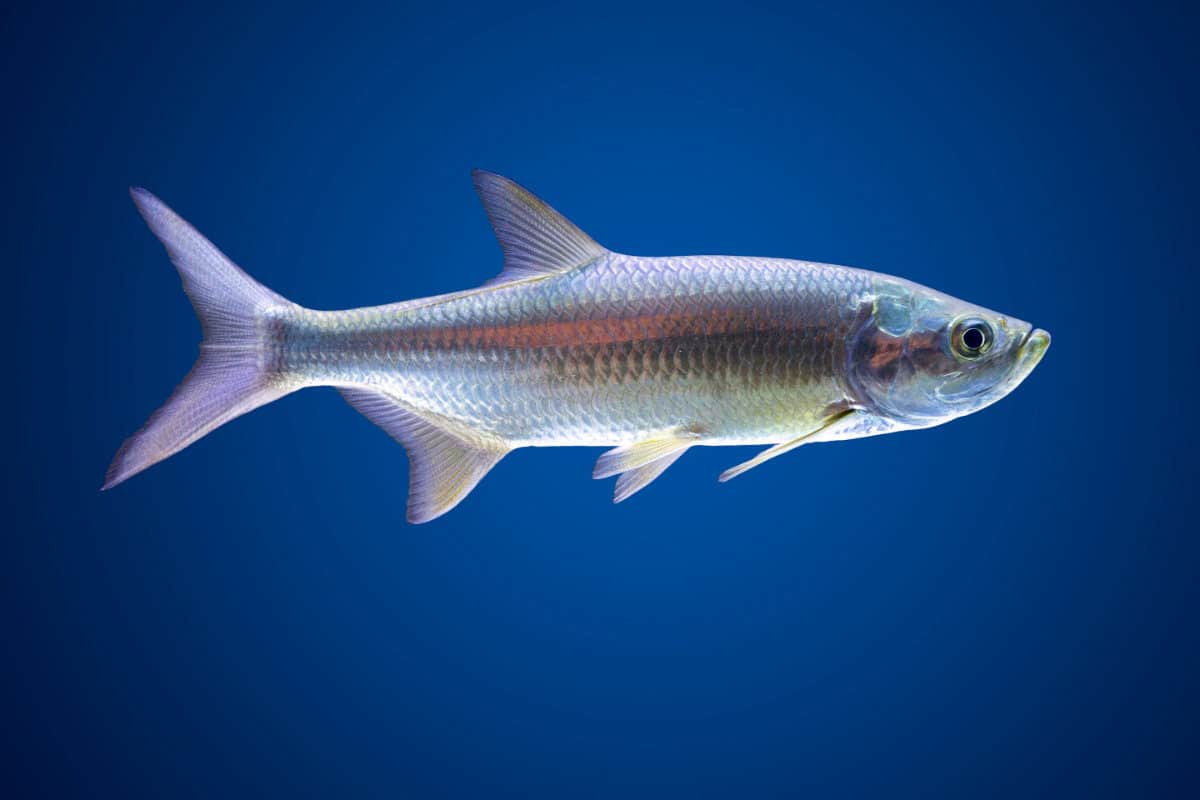
The Tarpon is one of the most sought after and highly prized game fish in Florida .
.
It packs a lot of punch, and it likes to fight a lot. This is making the Tarpon very fun fish catch.
Tarpons can be found in different places like beaches, rivers, channels, estuaries, river mouths, and more. They are a highly migratory type of fish.
16. Flounder (Fluke)
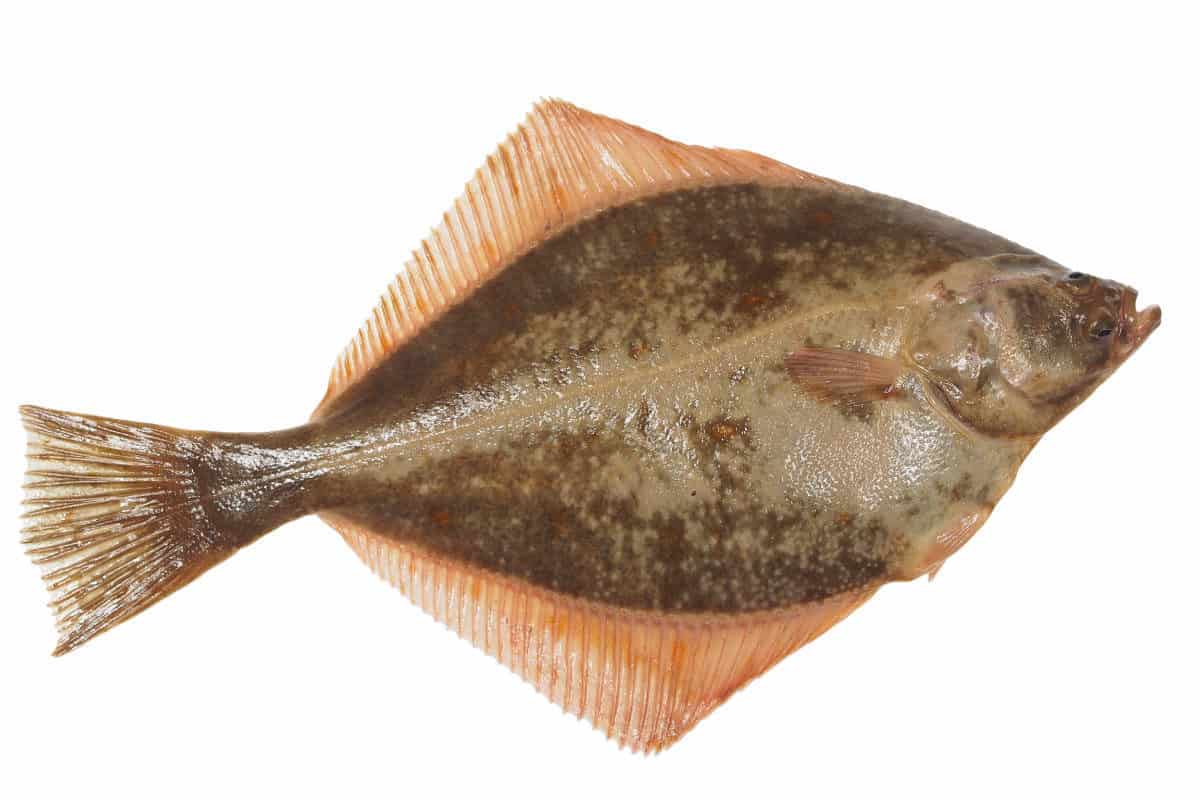
The Flounder is one of the fish species that can be caught very close to the shore in sand troves. Their native habitat is the northern areas of both the Atlantic and the Pacific Oceans.
Flounders don’t move a lot, so once you find the right school of these, you are good to go.
They can be caught with crab, sand fleas, shrimp, bucktail, swimming mullet, and more.
17. Redfish (Red Drum)
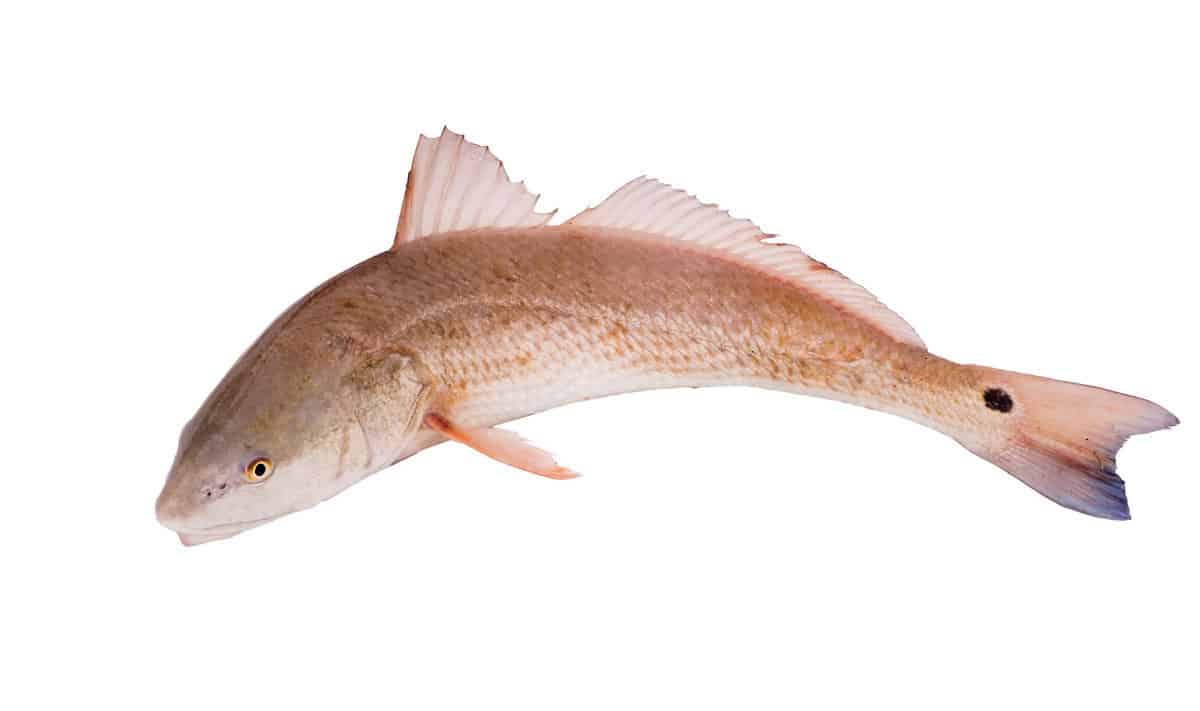
At one point, redfish were so much sought-after that they were nearly wiped out as a species. Fortunately, today, their population has returned to normal levels.
Redfish can be found throughout the East Coast, starting from Massachusetts down to Florida and throughout the Gulf of Mexico.
Redfish are known to prefer shallow waters near areas with more vegetation and floral structure. Younger redfish are found in estuaries, rivers, creeks, and bays. As they mature, they will leave these areas and go offshore.
18. Black Drum
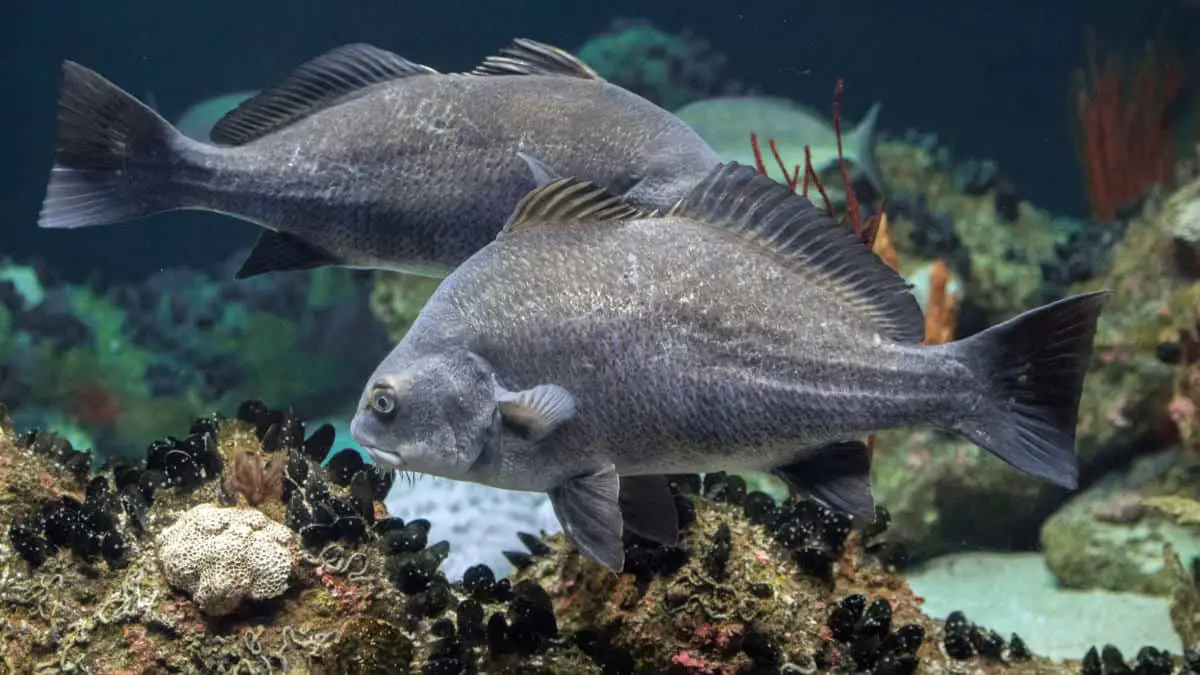
The Black drum is an enjoyable fish to catch.
It can be seen on the East Coast, starting from New York down to Florida and throughout the Gulf of Mexico. It inhabits both inshore and offshore areas.
The Black drum is best caught on life, or cut bait like crabs, sand fleas, shrimp, clams, but lures like bucktails can also be used successfully.
can also be used successfully.
19. Speckled Trout
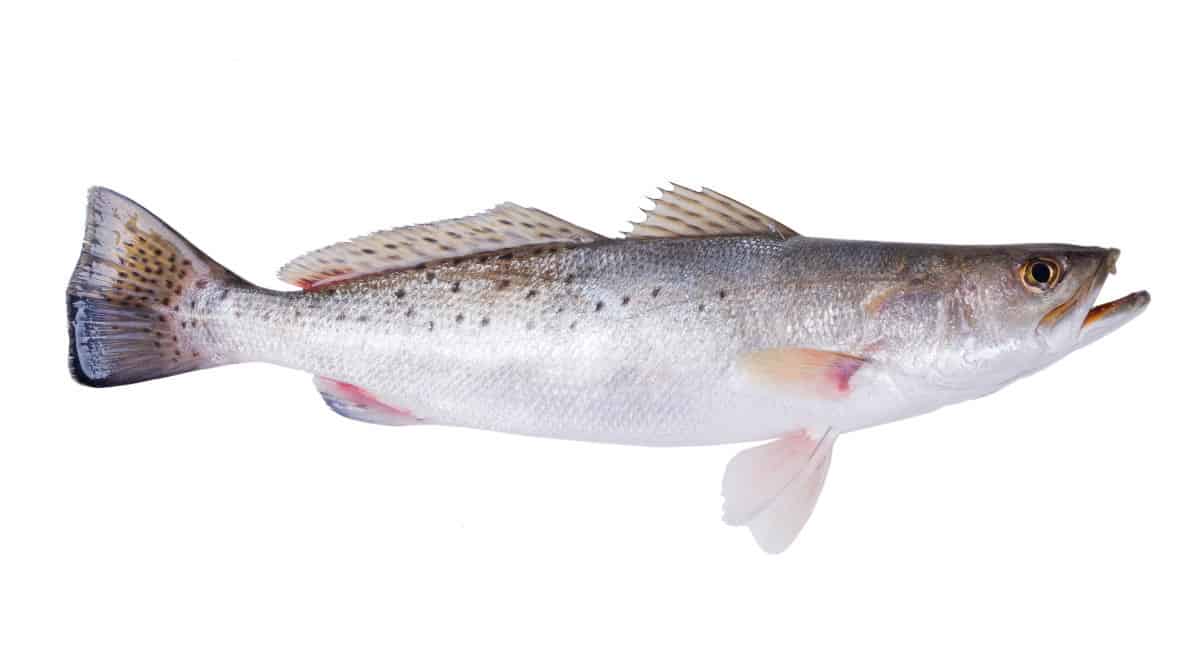
Also known as spotted sea trout. This is a prevalent fish species in Florida that inhabit shallow waters and can frequently be found in estuaries and bays.
They are predatory fish species that have two large canine teeth on their upper jaw.
20. Tautog (Blackfish)
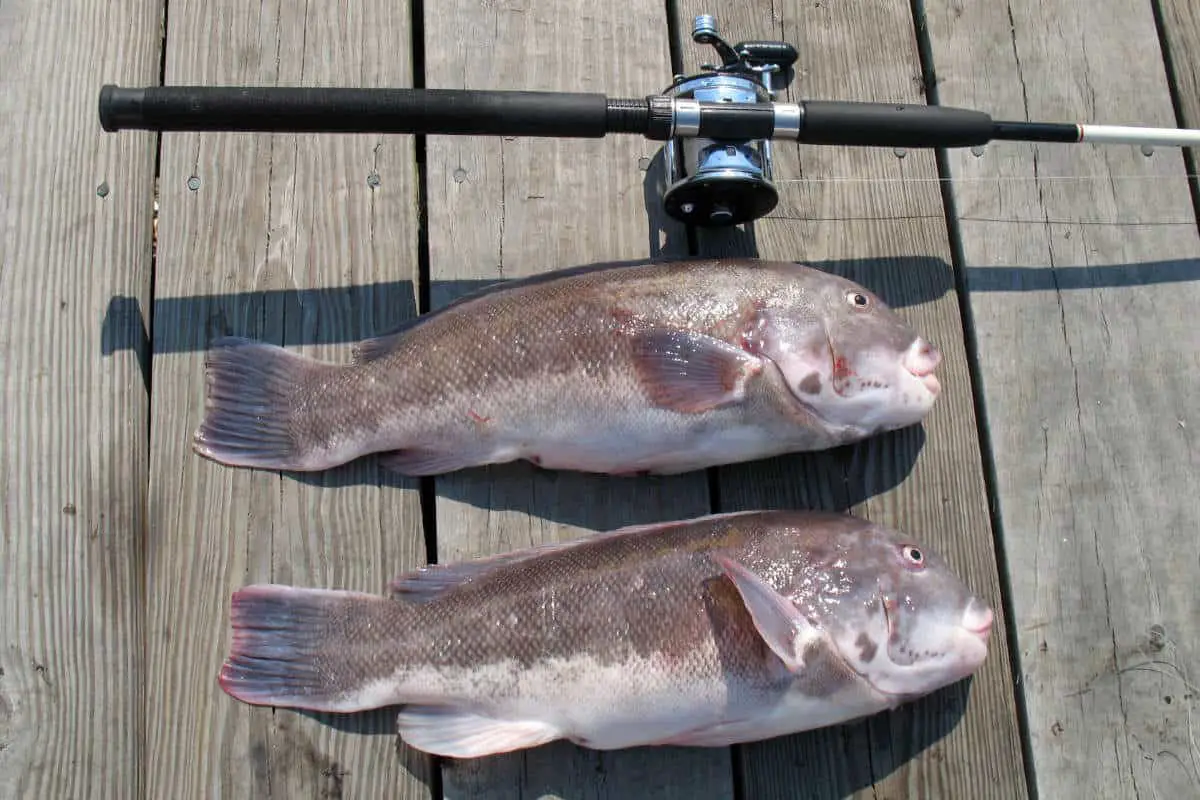
Tautog can be found on the East Coast from Maine to South Carolina.
These fish prefer staying near the bottom in areas with more structure: concrete, rubble, wooden, and rock piles. They can be found in varying depths starting from 3.3 and down to 246.1 feet.
21. Stingray and Skate
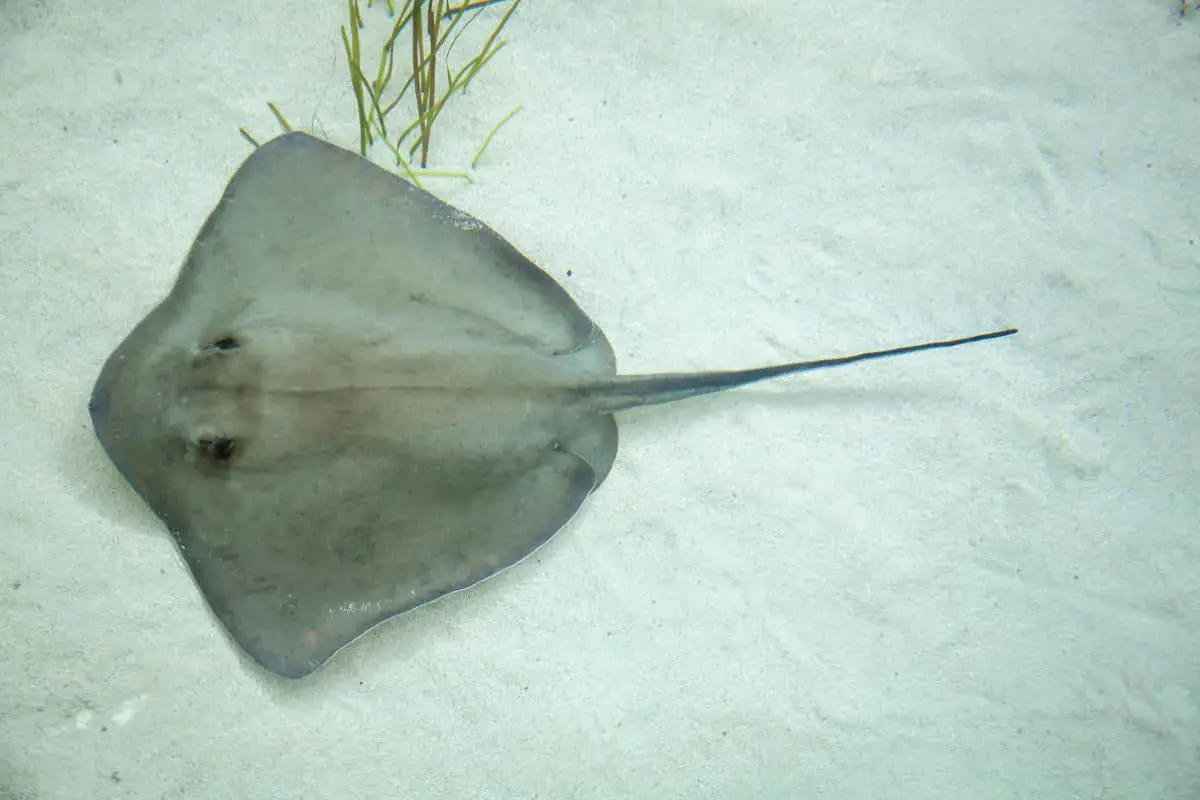
Both Stingrays and skates are a type of cartilaginous fish. These can be found in the coastal areas. It is not a rare occurrence for surf fishermen to encounter one of these.
Skates are relatively harmless as they do not have the sting which stingrays are well known for. They can, however, bite, which is not a very pleasant experience.
Stingrays are more dangerous. However, they are not aggressive and will not attack unless provoked in some way. Because they prefer to hide in the sand, they can easily be stepped on.
22. Cobia
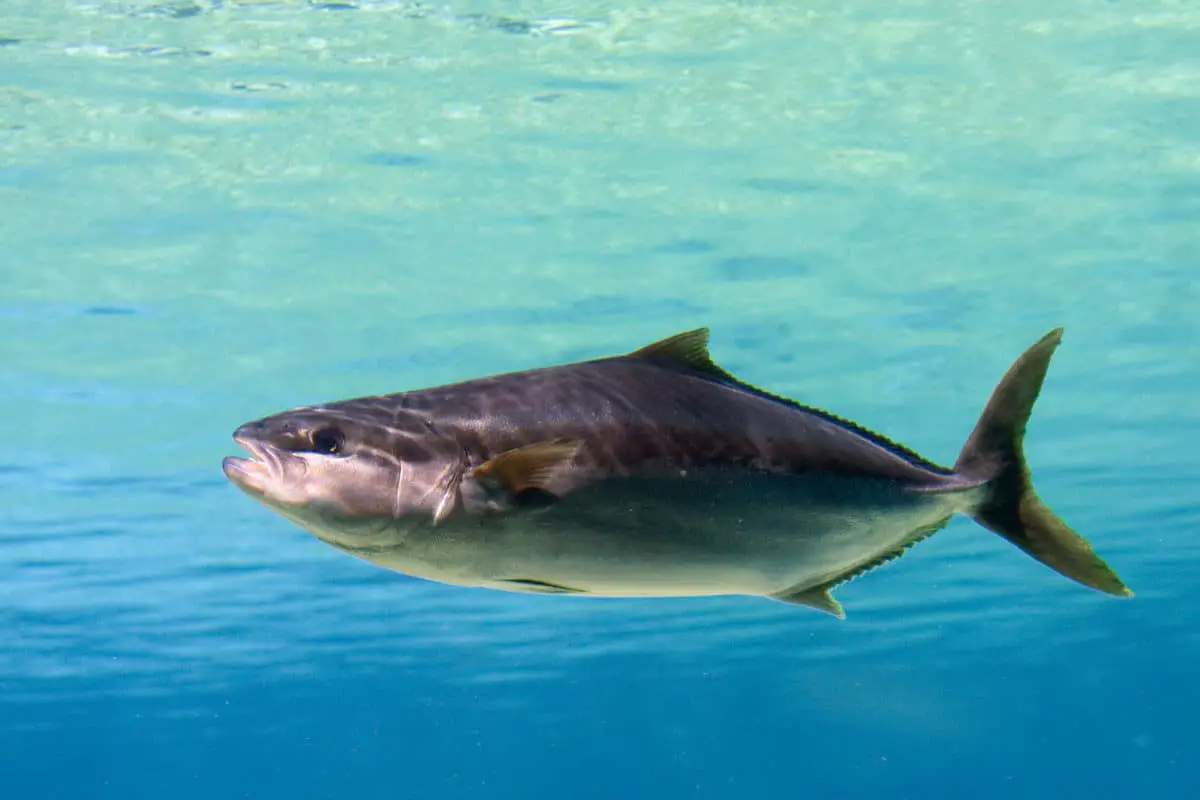
Cobia is very aggressive biters and overall a fun fish to go after. They are an awe-inspiring catch and are highly prized because of that.
The good thing is that they can be caught from the beach. They usually inhabit water depths of about 10 to 40 feet. They inhabit tropical and temperate waters, with the only exception being the West Coast.
Cobia can be caught with both live bait and artificial lures.
23. Sheepshead
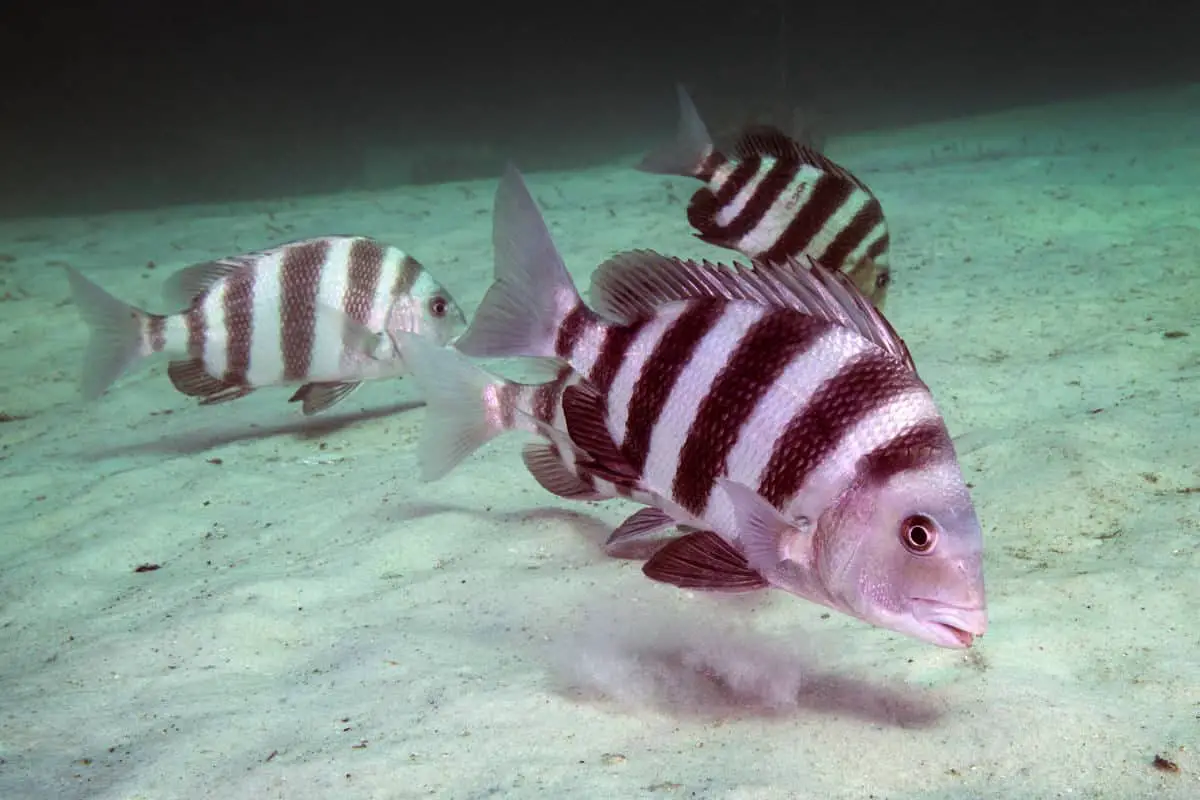
The Sheepshead is a fish species that can be found along the West Coast down to Florida and throughout the Gulf of Mexico.
These fish usually stay near places that provide cover and structure like jetties, reefs, piers, rock piles, and more. They are typically found in waters up to 50 feet in depth.
They can be caught with live or cut bait, shrimps, sand fleas, crabs, barnacles, and more.
24. Barracuda
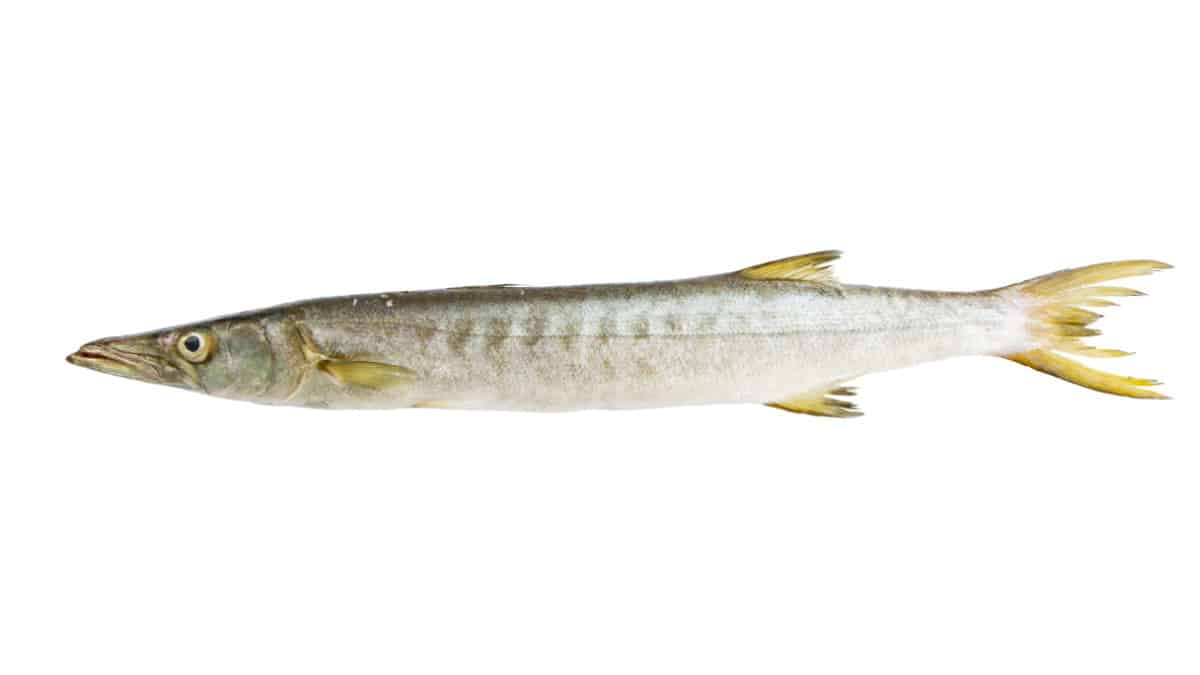
The barracuda can be found almost anywhere except the Pacific Ocean. They like tropical and temperate waters.
The great barracuda can be found in shallower waters below 50 feet. Usually, they stay closer to the surface of the water and prefer places with a structure such as mangroves, shipwrecks, seagrasses, and coral reefs.
The barracuda can be caught with fresh and cut bait like mackerel, bonito, sardines
A Few Points on What Types of Fish You Can Catch While Surf Fishing
Of course, the list I have provided above is not covering every single kind of fish you can catch from the beach.
There are just so many different types of fish out there.
When I first started, I was not too sure what fish I can or should target when surf fishing. I always wanted a simple guide like this one that will show me what are my options so that I do not go fishing blindly.
Hopefully, now you have a better understanding of what types of fish you can find while surf fishing in your area. That way, you can make your next fishing trip more productive.

